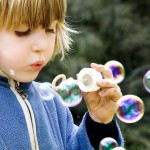 Increasingly we’re seeing early childhood education programs veering toward formal academic learning. This is a distressing trend, inasmuch as it makes young children do things (formal reading and math, computer instruction) that they are not developmentally ready for, and that take precious time away from letting children be children. There are no critical periods in early childhood during which a child must have exposure to formal reading and math, or computers, or they will never develop these capacities later in life. However, there are only these few precious years of life when the child’s brain is buzzing away at twice the metabolic level of an adult, and when the young child is open to a wide range of perceptions, senses, feelings, and other experiences.
Increasingly we’re seeing early childhood education programs veering toward formal academic learning. This is a distressing trend, inasmuch as it makes young children do things (formal reading and math, computer instruction) that they are not developmentally ready for, and that take precious time away from letting children be children. There are no critical periods in early childhood during which a child must have exposure to formal reading and math, or computers, or they will never develop these capacities later in life. However, there are only these few precious years of life when the child’s brain is buzzing away at twice the metabolic level of an adult, and when the young child is open to a wide range of perceptions, senses, feelings, and other experiences.
If you fill the young child’s time with academic activities and other preparations for elementary school, then you take away something that can never again be reclaimed: the magical years of play. Every early childhood education program should have free play as its central focus. Anything less than this is developmentally inappropriate, threatens to deprive the child of a solid multi-sensory experiential foundation for all future learning, and causes deterioration in brain connections that are related to art, music, nature, intuition, social interaction, physical expression, and a range of other culturally-valued domains. Here is just a sampling of the kinds of materials that should be in any early childhood education program (I’ve used Howard Gardner’s theory of multiple intelligences in organizing categories).
Linguistic: children’s books of all kinds, magazines for cut out, alphabet letters of different sizes and shapes, storytelling area, drawing implements and paper to practice emergent literacy; alphabet stamps, dolls that speak in different languages, word blocks, magnetic letters;
Logical-mathematical: things to count, sort and classify (e.g. buttons, coins, rocks, color swatches), number blocks of different sizes and shapes, scale to weigh things, measuring tape, measuring cups, calendars, clocks, and other time-related materials, cash register, play computer, magnets, lacing, beads, pattern puzzles, pattern blocks, abacus;
Spatial: pictures of all kinds, drawing, painting, and collage (paint, colored chalk, pens, collage materials, paste, play dough etc.); easels, puzzles, pegboards, parquetry sets, telescope, microscope, different colored materials to look through, maps, geometric shapes, cameras;
Musical: percussion instruments, electronic keyboard, drums, auto harp and other stringed instruments, music to listen to, containers with “mystery sounds”; stage for karaoke, everyday materials to create their own musical instruments (e.g. cardboard tubes, oatmeal box etc.), stethoscope to listen to things with;
Bodily-kinesthetic: hands-on manipulatives; dry sandbox with age appropriate toys (including bulldozers, small shovels, and other sand processers); wet sandbox; building materials (e.g. large legos, large wooden blocks, stacking blocks etc.), water table with cups, pans, cans, (to play “sink or float” etc.), gymnastic equipment, housekeeping toys (e.g. broom, dust pan etc.), balance beam, jump rope, tricycles and other transportation vehicles, ballgames, clay and mud areas, carpentry equipment and work bench, space to run, jump, and climb on ropes, ladders, nets, trees; building materials to create forts and other play spaces, containers with mystery tactile experiences, little doctor’s kit, space to dance, bean bags;
Interpersonal: household furniture, dress-up clothes for make-believe, doll house, dolls and stuffed animals of all kinds, miniature figures for play, puppets and puppet theater, stage for impromptu drama, board games, materials for creating playing at store, farm, village, or other social institutions; parachute, huge ball, tunnels, miniature vehicles, action figures, walkie-talkies;
Intrapersonal: private spaces to be alone, recorder to record voice, mirrors, sand play with miniature people, objects, houses to create worlds;
Naturalist: aquarium, terrarium, class pet, outside garden, indoor plants, materials for measuring weather (e.g. weather vane, rain gauge etc.), binoculars for bird watching, gardening equipment, miniature farms, and farm animals;
Tasting and Smelling: cooking and baking opportunities with an adult, containers with mystery smells; child-sized kitchen play area.
For more information about developmentally appropriate practices for early childhood education, see Thomas Armstrong, The Best Schools: How Human Development Research Should Inform Educational Practice (foreword by David Elkind).
This article was brought to you by Thomas Armstrong, Ph.D. and www.institute4learning.com.
Follow me on Twitter: @Dr_Armstrong




















This is an awesome take on early childhood learning, and quite a comprehensive and inspiring list of resources. Thank you!!
Thanks so much!